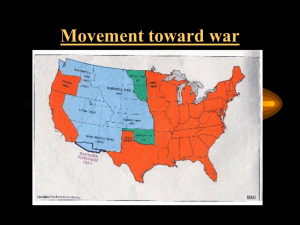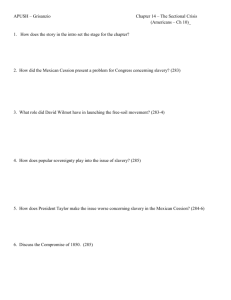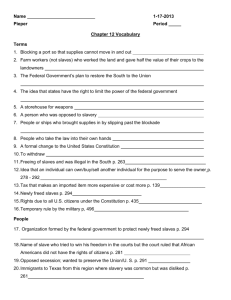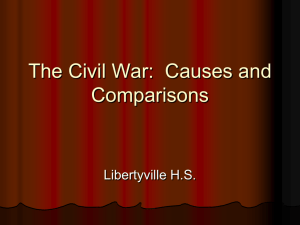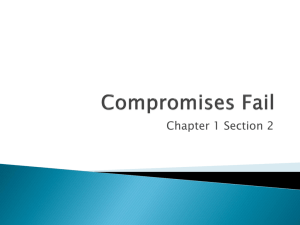War with Mexico
advertisement
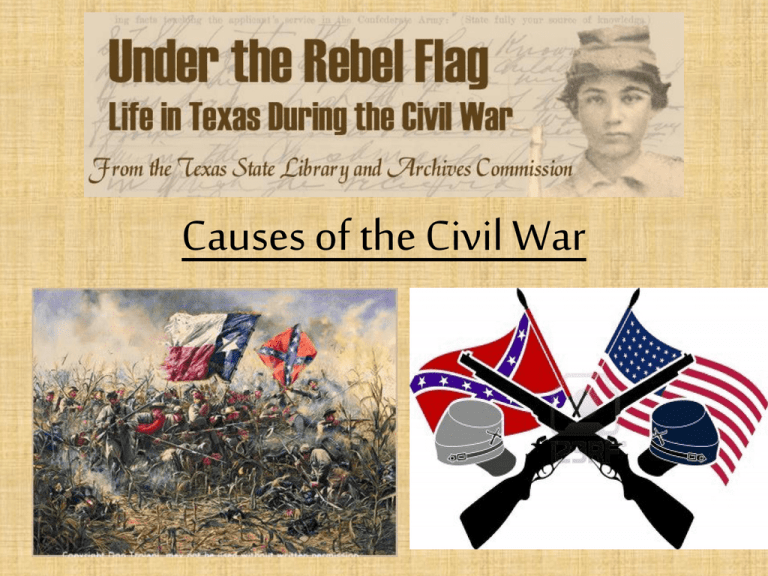
Causes of the Civil War Slavery in Texas (1) • • • • Many settlers brought slaves with them to Texas Was a cheap source of labor to work the cotton fields Slaves were considered property Some slaves escaped to Mexico, where slavery was illegal. Slavery in Texas (2) • Most Northerners opposed slavery (there was some slavery there…..surprising right) • In the South, many people feared that the loss of slavery would bankrupt the South • The South threatened to secede (withdraw) from the Union if slavery was outlawed Growing Slave Population in Texas, 1825-1860 The Nation Splits Apart (3) • Kansas-Nebraska Act of 1854 – gave the people of Kansas and Nebraska the right to decide if their states would allow slavery. – Many Southerners favored this act, most Northerners did not – People “snuck” into Kansas to vote – Fighting took place – “Bleeding Kansas” Bleeding Kansas (4) • The Kansas-Nebraska Act said that the people of a new territory would decide for themselves whether the state would enter the Union as a slave state or a free state. • When Kansas tried to enter Union, pro-slavery men from Missouri flooded into Kansas to make sure it entered as a slave state. • They were countered by free state supporters (including John Brown and his sons) who came into Kansas to make sure that it came in as a free state. • Violence broke out on a large scale. Pro-slavery men and antislavery men set up rival constitutional conventions and nobody really had a clue what to do. • Dozens of men (perhaps many more) were killed in violence between the two rival factions and endless fighting resulted. • It wasn't until the Civil War broke out that the situation was resolved; Union troops basically took over the place and Kansas entered the Union as a free state in 1864. The Nation Splits Apart (5) • States’ rights – the idea that states have the right to limit the power of the federal government – Most Southerners believed that the federal government went beyond its power by limiting the spread of slavery The Nation Splits Apart (6) • Agriculture vs. Industry – The South had ranching and farming – Depended on the North to manufacture raw goods into finished products – Example…cotton into cloth – The North had factories, manufacturing, and more transportation – Had subsistence farming, so could provide for their own families (not to sell) – Made money from manufacturing Southern goods – When the U.S. splits apart both sides are hurt The Nation Splits Apart (7) • Nationalism v. Sectionalism – The people in the North saw themselves as Northerners and as members of their respective state, not as citizens of the United States – The people in the South saw themselves as Southerners and as members of their respective state, not as citizens of the United States – Each section thought they were better than the other – Should have seen themselves as an entire nation not as sections The Nation Splits Apart (8) • Dred Scott vs. Sandford – This landmark Supreme Court case ruled that African Americans did not have the rights of citizens – Slaves were property not people – This ruling prevented the U.S. Congress from outlawing slavery in the territories John Brown’s Raid (9) • On October 16, 1859, John Brown led a small army of 18 men into the small town of Harper’s Ferry, Virginia. • His plan was to instigate a major slave rebellion in the South. • He would seize the arms and ammunition in the federal arsenal, arm slaves in the area and move south along the Appalachian Mountains, attracting slaves to his cause. • He had no rations. He had no escape route. His plan was doomed from the very beginning. But it did succeed to deepen the divide between the North and South. • When he was captured, he was publicly hung in Charles Town, West Virginia. • • • • • Abraham Lincoln Elected (10) Runs as a Republican Wants to stop the SPREAD of slavery, not ABOLISH it Is elected November 6, 1860 South Carolina secedes December 20, 1860 11 other southern states quickly follow Texas Secedes (11) • The Secession Convention – Oran M. Roberts, chief justice of the Texas Supreme Court – called a convention to discuss Texas leaving the Union – Sam Houston urged Texas NOT to secede (wasn’t reelected) – The delegates voted 166 to 8 to secede – On February 23, 1861, the people of Texas voted to secede Texas Secedes (12) • Texas Joins the Confederacy –Soon after the vote, Texas delegates helped to establish the Confederate States of America. –On March 5, 1861, the Secession Convention declared Texas independent of the United States

